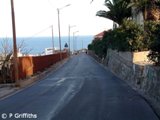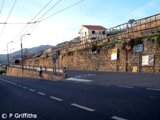Top 20 Major Classics #15
Milan-San Remo 1992: Kelly's Daredevil Descent
CR Timeline 1992 xxxx YouTube: Milan-San Remo 1992
The route of Milan-San Remo traces the Italian Rivera for most of the second half of the race. The final obstacle for many years was the Cipressa climb at the 21.6 km to go mark. As the race moved into the modern era any fragmentation of the peloton occurring on the Cipressa climb was often erased on the descent and long run into San Remo. To combat the almost inevitable bunch sprint finish each year the organizers added the now famous Poggio climb. This tough climb starts 5.7 km from the finish and is followed by a sinuous and very technical descent that spills out into the streets of San Remo. The final dash is three flat kilometers from the base of the Poggio to the finish line along the Via Roma.
Once over the Cipressa the race hugs the coast until an inconspicuous road to the right, signposted ‘Poggio', brings the race to its final great battle ground. For about 2 km the road goes up at about 6% and if you have watched the race on TV will remember the hairpins, small holdings and greenhouses. The gradient eases at the Hotel Belvedere and there is a breathtaking view out to sea. A short 7% incline follows and then eases off to rise gently to the summit.

   
(L to R) San Remo below, narrow descending road, fast downhill turn tight hair-pin turns ( Images © M-SR: P Griffiths Easy Imager )
For the racers it is a very fast and nerve racking descent back down to sea level. On the narrow switch-back turns a rider must brake at the last moment and sprint quickly back up to speed. In order to win a rider must take huge risks on this heart-stopping descent.
Great Italian classics rider Moreno Argentin had never won Milan-San Remo. He came to the 83 rd Edition of this Italian Monument in 1992 with high hopes and great fitness. Over the Cipressa and on the road to the Poggio 10 km distant, Agentin's Ariostea team had overwhelming confidence in their team leader as they set an incredible pace.
t the foot of the Poggio French rider Eric Boyer attacked. The Ariostea team neutralized the move within one kilometer. Just as the junction was made Argentin launched a massive attack and opened a small gap. Behind him 36 year old Sean Kelly led the strung-out peloton in pursuit. The Irishman once said, “If you have a 100 meter lead at the top of the Poggio, you'll win.” Kelly's statement was put to the test in 1992. After watching Argentin ride away, Kelly started the descent of his life.

*Race profile courtesy of Internet site: www.econ-outlook.com.au/tom/cycling/palmares.html
After more than 7 hours of racing Kelly descended like a mad man. Flying into and out of every hairpin turn, Kelly slowly closed the gap on Argentin. Inside the last 3 km to go at the bottom of the Poggio Kelly made contact with a very surprised Argentin.

Entry to the finish straight ( Image © M-SR: P Griffiths Easy Imager )
As they rode onto the Via Roma the peloton was closing quickly. Aggressively the Italian led out the sprint. Kelly, a solid sprinter, easily came by Argentin for the victory.
Sean Kelly's Milan-San Remo victory was his second, but it was his dare-devil descent that made the 1992 M-SR a cycling legend. At 36 years of age this race was his last major victory before retiring two years later.
Milan-San Remo March 21, 1992 |
294 Km |
1. Sean KELLY (IrI) 7h31'42" |
| 2. Moreno Argentin (Ita) |
| 3. Johan Museeuw (Bel) +03" |
Starters: 219 |
Finishers: 206 * |
Average Speed: 39.052 km/h |
SPECIAL NOTE: * 206 was a record number of finishers.
Return to ToC |
